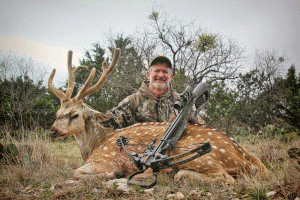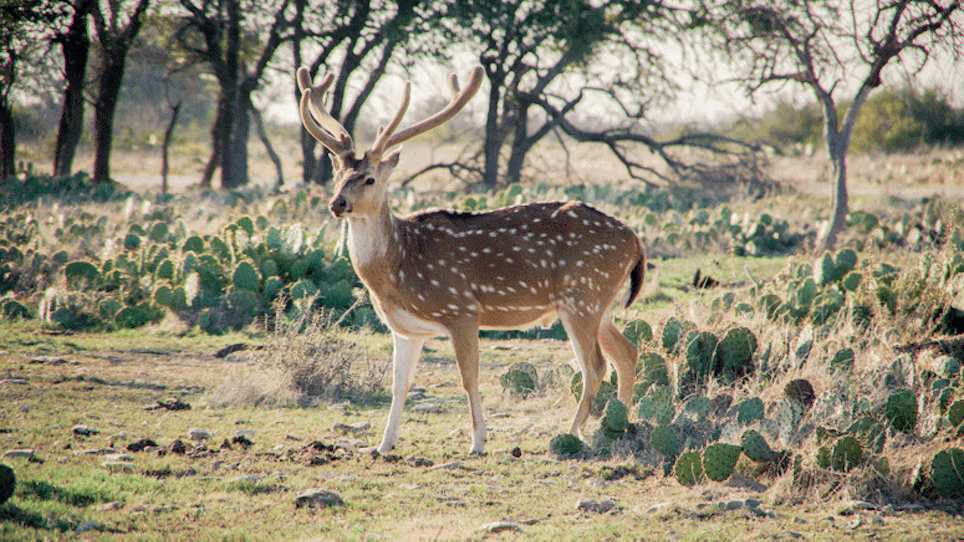It was unseasonably warm for mid-February, even for south Texas, as I settled into my ground blind to see what might turn up that afternoon. The first three blind shifts had been unproductive only in that I had yet to have an opportunity at something I was hoping for — a nice axis deer buck and, later, a fat doe.
Axis meat is without question some of the finest wild table fare on the continent, and after something of a lean fall, my freezer was a little low and Cheryl was starting to grumble. You know the drill, the one where your spouse gives you that look that says, “I thought you were a decent hunter and could keep us in meat, but maybe I need to head for Costco and stock up.”
I was at the plush JL Bar Ranch & Resort in South Texas, a place loaded with exotic animals. Exotics in Texas can pretty much be hunted year-round, making it a great off-season gig, and on the JL we could take either an axis deer or fallow deer buck, plus a doe.
The game plan was pretty basic: up long before dawn, eat breakfast and be in the blind 30 minutes before first light. Hunt all morning, come back for lunch and some work, back out in the evening, hunting until dark, then feast on some of the JL’s incredible food. Rough, huh?
So on evening two, an hour before what we would have considered “prime time,” two axis bucks showed up. We had moved locations, and it paid off. I had my choice. One buck was youngish, but fat and prime. The other? Well, he was a lot like me, older, gray in the face, with a sway back and knobby knees, moving a little slower than he used to.
The decision was easy. Take the older guy. He needed to be removed from the herd, and besides, I felt a bit of kinship with this 8-9-year-old stud. I rested my crossbow on the Bog Pod tripod sticks, settled the 30-yard mark on the scope’s reticle on the sweet spot and squeezed the trigger. The hybrid Grave Digger broadhead cut a massive hole, and the buck was down and out within 75 yards.
The next morning I was in a new blind, and an hour after you could see, we were covered up in animals. There were eight axis deer, including one really good buck and four whitetail does. I chose a fat mature axis doe, and once again the crossbow sent a laser beam on its way. Just like that, I had enough superb meat to make Cheryl happy.
Pursuing exotics in Texas is a great way for hunters to spend quality time afield under conditions that are ideal for using a crossbow. There is a lot of game, shots are taken under controlled conditions and chances for success run very high. Often you can do a hunt over a long weekend, saving precious vacation days. Costs are reasonable and, of course, vary depending upon where you go and who you hunt with. And the meat is hard to beat.
It’s something I will be doing many more times.
About Axis Deer
The axis deer, or chital (Cervus axis Erxleben), is native to the Indian subcontinent. It sports a bright reddish coat marked with rows of white spots that persist throughout life. Antlers of males are large but simple, usually with only three points.
Adult males weigh up to 200 pounds, and large females weigh in at about 130 pounds. The axis deer was first introduced into Texas in the 1930s, and now occurs in at least 45 counties. Essential habitat components include water, woody vegetation for cover and open areas for feeding. This deer is primarily a grazer, but its food habits are very general, and it can exist quite easily on forbs and woody browse.
The reproductive activity of the axis occurs year-round, but most breeding occurs in June and July. Single fawns are born the following spring after a 7½-month gestation period. During the breeding period males bellow loudly and wander in search of receptive females. Females mature sexually and first breed at 14-17 months of age. Males are probably capable of breeding as yearlings but must achieve adult size to compete for females.
Axis deer are more active by day than by night, with greatest activity occurring for two to three hours after dawn and again before dark. The size of the home range varies with habitat and averages 2½ square miles in the coastal live oak region. Axis deer do not seem to be territorial, but males fight, often with serious consequences, for possession of females.
With few exceptions, in Texas axis deer are not regulated by game laws. While there is some axis deer hunting on public land, the vast majority occurs on private ranches. On private land axis deer are considered landowners’ property and may be bought, sold or hunted at any time. Therefore, they are important in sports hunting and offer hunting opportunities at times when native species are not available. Ranchers stock them for this purpose, and this practice explains their wide distribution in the state. A big bonus — the meat is lean, mild and devoid of any type of “sagebrush” taste. It’s some of the best I’ve ever eaten.






